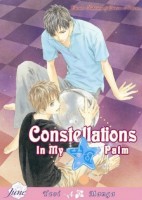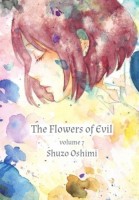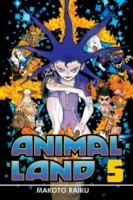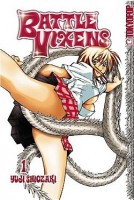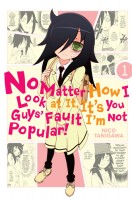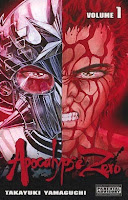My News and Reviews
October is finally over, and I somehow managed to survive! I’ve been extremely busy at work which bled over into the rest of my life and has interfered with a lot of things that I would otherwise rather be doing. I’m really hoping that my stress levels and schedule settle down a bit in November, but my immediate supervisor is retiring in December and I’ll be taking on some more responsibilities in my unit (at least temporarily), so we’ll see how that goes! Anyway, I was somehow able to keep on top of my posts here at Experiments in Manga. The most recent manga giveaway is currently in progress and there’s still time to enter for a chance to win Sherlock Bones, Volume 1. Since this past Friday was Hallowe’en, I decided it would be appropriate to review Junji Ito’s manga Uzumaki: Spiral into Horror. It’s been deservedly called a masterpiece, and the deluxe omnibus edition is especially nice. And over the weekend, I posted October’s Bookshelf Overload for those of you interested in what made it onto my bookshelves last month. I’m sure there was plenty of interesting reading to be found online, but I’m afraid I’ve been so busy I haven’t been able to pay much attention recently. Let me know if I missed something particularly good!
Quick Takes
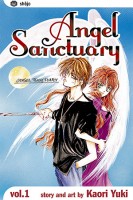 Angel Sanctuary, Volumes 1-5 by Kaori Yuki. It’s pretty clear after reading the first few volumes of Angel Sanctuary that this manga is going to be epic, for better or for worse. Angel Sanctuary has a huge cast (most with multiple names and multiple identities) and easily enough material for several completely different and unrelated series. So much is crammed into the early volumes that I’m afraid that Yuki might be trying to do too much at once with the manga. Though he is initially unaware of it, Setsuna is the reincarnation of the angel Alexiel, fated to suffer for her past deeds life after life. This causes significant problems for him—other angels and demons are searching for Alexiel, some to reawaken her soul and some to completely destroy her. But even more problematic is Setsuna’s incestuous love for his younger sister Sara. So far the story is somewhat confusing and difficult to follow, albeit with moments of brilliance. However, I do consistently enjoy Yuki’s gothic artwork, tragic melodrama, and gender play. Many of Yuki’s angels also happen to be sexist assholes, completely capable of murder, deception, and greed, which is certainly an interesting take on the celestial beings.
Angel Sanctuary, Volumes 1-5 by Kaori Yuki. It’s pretty clear after reading the first few volumes of Angel Sanctuary that this manga is going to be epic, for better or for worse. Angel Sanctuary has a huge cast (most with multiple names and multiple identities) and easily enough material for several completely different and unrelated series. So much is crammed into the early volumes that I’m afraid that Yuki might be trying to do too much at once with the manga. Though he is initially unaware of it, Setsuna is the reincarnation of the angel Alexiel, fated to suffer for her past deeds life after life. This causes significant problems for him—other angels and demons are searching for Alexiel, some to reawaken her soul and some to completely destroy her. But even more problematic is Setsuna’s incestuous love for his younger sister Sara. So far the story is somewhat confusing and difficult to follow, albeit with moments of brilliance. However, I do consistently enjoy Yuki’s gothic artwork, tragic melodrama, and gender play. Many of Yuki’s angels also happen to be sexist assholes, completely capable of murder, deception, and greed, which is certainly an interesting take on the celestial beings.
 The Flowers of Evil, Volumes 10-11 by Shuzo Oshimi. Several years have passed since the incident in Kasuga’s hometown and his tumultuous relationship with Nakamura. The time has now come for him to face everything that he has done in his past and to confront how his actions have affected the people in his life—his family, his former classmates, his girlfriend, and most importantly himself. Up until now, he has been unable to move on with his life. His past, though he tries to hide it or run away from it, still defines who he is. The finale of The Flowers of Evil is a very effective exploration of personal identity and responsibility. Oshimi’s artwork, while never awful, has improved tremendously since the beginning of the series. This is particularly important for the last two volumes of The Flowers of Evil since large portions of the manga are completely without dialogue or narration; the art must be strong enough to carry the story entirely on its own, and it succeeds in that. The Flowers of Evil is a surprising series, ending with a very different tone and in a very different place than where it first began. It was quite a journey and it was worth every page.
The Flowers of Evil, Volumes 10-11 by Shuzo Oshimi. Several years have passed since the incident in Kasuga’s hometown and his tumultuous relationship with Nakamura. The time has now come for him to face everything that he has done in his past and to confront how his actions have affected the people in his life—his family, his former classmates, his girlfriend, and most importantly himself. Up until now, he has been unable to move on with his life. His past, though he tries to hide it or run away from it, still defines who he is. The finale of The Flowers of Evil is a very effective exploration of personal identity and responsibility. Oshimi’s artwork, while never awful, has improved tremendously since the beginning of the series. This is particularly important for the last two volumes of The Flowers of Evil since large portions of the manga are completely without dialogue or narration; the art must be strong enough to carry the story entirely on its own, and it succeeds in that. The Flowers of Evil is a surprising series, ending with a very different tone and in a very different place than where it first began. It was quite a journey and it was worth every page.
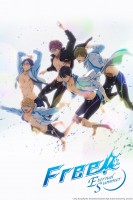 Free!: Eternal Summer directed by Hiroko Utsumi. I rather enjoyed the first season of Free! and was pleasantly surprised to discover that in addition to its goofiness the anime series actually had some substance to it. And so I was looking forward to watching its second season, Eternal Summer. A lot of the humor and drama in the second season comes from the introduction of several new characters. It was a little strange to have best friends suddenly appear when I’m pretty sure they weren’t even hinted at in the first season, but I ended up really liking the additions to the cast. Although most of the characters see some development, most striking is how much Rin has changed from the first season. His anger and angst is mostly gone and he’s become fairly chill, although he’s still very passionate about swimming. It’s a passion that he shares with the other swimmers in the anime, but each has his own approach and way of expressing it. They really don’t always make the best, wisest, or most mature decisions, though. (Not that I would expect that teenagers would.) Driving the narrative of Eternal Summer is the characters’ struggles and searches for their dreams and futures. The season provided a very satisfying conclusion to Free!.
Free!: Eternal Summer directed by Hiroko Utsumi. I rather enjoyed the first season of Free! and was pleasantly surprised to discover that in addition to its goofiness the anime series actually had some substance to it. And so I was looking forward to watching its second season, Eternal Summer. A lot of the humor and drama in the second season comes from the introduction of several new characters. It was a little strange to have best friends suddenly appear when I’m pretty sure they weren’t even hinted at in the first season, but I ended up really liking the additions to the cast. Although most of the characters see some development, most striking is how much Rin has changed from the first season. His anger and angst is mostly gone and he’s become fairly chill, although he’s still very passionate about swimming. It’s a passion that he shares with the other swimmers in the anime, but each has his own approach and way of expressing it. They really don’t always make the best, wisest, or most mature decisions, though. (Not that I would expect that teenagers would.) Driving the narrative of Eternal Summer is the characters’ struggles and searches for their dreams and futures. The season provided a very satisfying conclusion to Free!.

